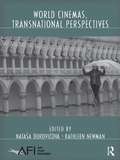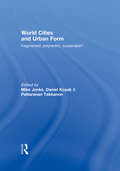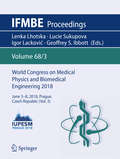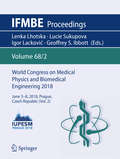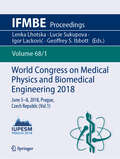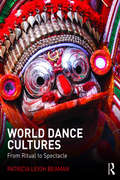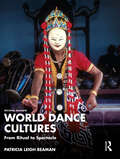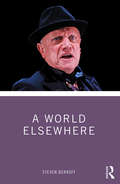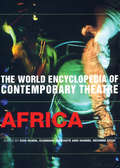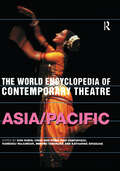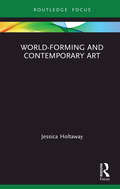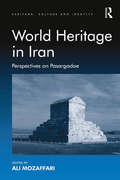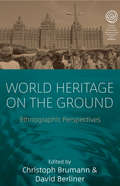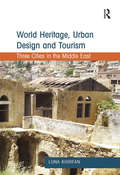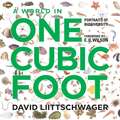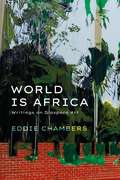- Table View
- List View
World Cinemas, Transnational Perspectives (AFI Film Readers)
by Natasa Durovicová Kathleen E. NewmanSCMS Award Winner "Best Edited Collection" The standard analytical category of "national cinema" has increasingly been called into question by the category of the "transnational." This anthology examines the premises and consequences of the coexistence of these two categories and the parameters of historiographical approaches that cross the borders of nation-states. The three sections of World Cinemas, Transnational Perspectives cover the geopolitical imaginary, transnational cinematic institutions, and the uneven flow of words and images.
World Cities and Urban Form: Fragmented, Polycentric, Sustainable?
by Mike Jenks Daniel Kozak Pattaranan TakkanonThis book presents new research and theory at the regional scale showing the forms metropolitan regions might take to achieve sustainability. At the city scale the book presents case studies based on the latest research and practice from Europe, Asia and North America, showing how both planning and flagship design can propel cities into world class status, and also improve sustainability. The contributors explore the tension between polycentric and potentially sustainable development, and urban fragmentation in a physical context, but also in a wider cultural, social and economic context.
World Cities and Urban Form: Fragmented, Polycentric, Sustainable?
by Mike Jenks Daniel Kozak Pattaranan TakkanonThis book presents new research and theory at the regional scale showing the forms metropolitan regions might take to achieve sustainability. At the city scale the book presents case studies based on the latest research and practice from Europe, Asia and North America, showing how both planning and flagship design can propel cities into world class status, and also improve sustainability. The contributors explore the tension between polycentric and potentially sustainable development, and urban fragmentation in a physical context, but also in a wider cultural, social and economic context.
World Congress on Medical Physics and Biomedical Engineering 2018: June 3-8, 2018, Prague, Czech Republic (Vol.3) (IFMBE Proceedings #68/3)
by Lenka Lhotska Lucie Sukupova Igor Lacković Geoffrey S. IbbottThis book (vol. 3) presents the proceedings of the IUPESM World Congress on Biomedical Engineering and Medical Physics, a triennially organized joint meeting of medical physicists, biomedical engineers and adjoining health care professionals. Besides the purely scientific and technological topics, the 2018 Congress will also focus on other aspects of professional involvement in health care, such as education and training, accreditation and certification, health technology assessment and patient safety. The IUPESM meeting is an important forum for medical physicists and biomedical engineers in medicine and healthcare learn and share knowledge, and discuss the latest research outcomes and technological advancements as well as new ideas in both medical physics and biomedical engineering field.
World Congress on Medical Physics and Biomedical Engineering 2018: June 3-8, 2018, Prague, Czech Republic (Vol.2) (IFMBE Proceedings #68/2)
by Lenka Lhotska Lucie Sukupova Igor Lacković Geoffrey S. IbbottThis book (vol. 2) presents the proceedings of the IUPESM World Congress on Biomedical Engineering and Medical Physics, a triennially organized joint meeting of medical physicists, biomedical engineers and adjoining health care professionals. Besides the purely scientific and technological topics, the 2018 Congress will also focus on other aspects of professional involvement in health care, such as education and training, accreditation and certification, health technology assessment and patient safety. The IUPESM meeting is an important forum for medical physicists and biomedical engineers in medicine and healthcare learn and share knowledge, and discuss the latest research outcomes and technological advancements as well as new ideas in both medical physics and biomedical engineering field.
World Congress on Medical Physics and Biomedical Engineering 2018: June 3-8, 2018, Prague, Czech Republic (Vol.1) (IFMBE Proceedings #68/1)
by Lenka Lhotska Lucie Sukupova Igor Lacković Geoffrey S. IbbottThis book (vol. 1) presents the proceedings of the IUPESM World Congress on Biomedical Engineering and Medical Physics, a triennially organized joint meeting of medical physicists, biomedical engineers and adjoining health care professionals. Besides the purely scientific and technological topics, the 2018 Congress will also focus on other aspects of professional involvement in health care, such as education and training, accreditation and certification, health technology assessment and patient safety. The IUPESM meeting is an important forum for medical physicists and biomedical engineers in medicine and healthcare learn and share knowledge, and discuss the latest research outcomes and technological advancements as well as new ideas in both medical physics and biomedical engineering field.
World Dance Cultures: From Ritual to Spectacle
by Patricia Leigh BeamanFrom healing, fertility and religious rituals, through theatrical entertainment, to death ceremonies and ancestor worship, World Dance Cultures introduces an extraordinary variety of dance forms practiced around the world. This highly illustrated textbook draws on wide-ranging historical documentation and first-hand accounts, taking in India, Bali, Java, Cambodia, China, Japan, Hawai’i, New Zealand, Papua New Guinea, Africa, Turkey, Spain, Native America, South America, and the Caribbean. Each chapter covers a certain region’s distinctive dances, pinpoints key issues and trends from the form’s development to its modern iteration, and offers a wealth of study features including: Case Studies – zooming in on key details of a dance form’s cultural, historical, and religious contexts ‘Explorations’ – first-hand descriptions of dances, from scholars, anthropologists and practitioners ‘Think About’ – provocations to encourage critical analysis of dance forms and the ways in which they’re understood Discussion Questions – starting points for group work, classroom seminars or individual study Further Study Tips – listing essential books, essays and video material. Offering a comprehensive overview of each dance form covered with over 100 full color photos, World Dance Cultures is an essential introductory resource for students and instructors alike.
World Dance Cultures: From Ritual to Spectacle
by Patricia Leigh BeamanFrom healing, fertility, and religious rituals, through theatrical entertainment, to death ceremonies and ancestor worship, the updated and revised second edition of World Dance Cultures introduces an extraordinary variety of dance forms and their cultures, which are practiced around the world. This highly illustrated textbook draws on wide-ranging historical documentation and first-hand accounts taking in India, Bali, Java, Cambodia, China, Japan, Hawai‘i, New Zealand, Papua New Guinea, Africa, Türkiye, Spain, Native America, South America, and the Caribbean, with this second edition adding new chapters on the Pacific Islands, Southern Africa, France, and Cuba. Each chapter covers a certain region’s distinctive dances, pinpoints key issues and trends from the form’s development to its modern iteration, and offers a wealth of study features including: • Spotlights zooming in on key details of a dance form’s cultural, historical, and religious contexts • Explorations—first-hand descriptions by famous dancers and ethnographers, excerpts from anthropological fieldwork, or historical writings on the form • Think About—provocations to encourage critical analysis of dance forms and the ways in which they’re understood • Discussion Questions—starting points for group work, classroom seminars, or individual study. Offering a comprehensive overview of each dance form covered with over 100 full color photos, World Dance Cultures is an essential introductory resource for students and instructors alike.
World Dance Cultures: From Ritual to Spectacle
by Patricia Leigh BeamanFrom healing, fertility, and religious rituals, through theatrical entertainment, to death ceremonies and ancestor worship, the updated and revised second edition of World Dance Cultures introduces an extraordinary variety of dance forms and their cultures, which are practiced around the world. This highly illustrated textbook draws on wide-ranging historical documentation and first-hand accounts taking in India, Bali, Java, Cambodia, China, Japan, Hawai‘i, New Zealand, Papua New Guinea, Africa, Türkiye, Spain, Native America, South America, and the Caribbean, with this second edition adding new chapters on the Pacific Islands, Southern Africa, France, and Cuba. Each chapter covers a certain region’s distinctive dances, pinpoints key issues and trends from the form’s development to its modern iteration, and offers a wealth of study features including: • Spotlights zooming in on key details of a dance form’s cultural, historical, and religious contexts • Explorations—first-hand descriptions by famous dancers and ethnographers, excerpts from anthropological fieldwork, or historical writings on the form • Think About—provocations to encourage critical analysis of dance forms and the ways in which they’re understood • Discussion Questions—starting points for group work, classroom seminars, or individual study. Offering a comprehensive overview of each dance form covered with over 100 full color photos, World Dance Cultures is an essential introductory resource for students and instructors alike.
World Dance Cultures: From Ritual to Spectacle
by Patricia Leigh BeamanFrom healing, fertility and religious rituals, through theatrical entertainment, to death ceremonies and ancestor worship, World Dance Cultures introduces an extraordinary variety of dance forms practiced around the world. This highly illustrated textbook draws on wide-ranging historical documentation and first-hand accounts, taking in India, Bali, Java, Cambodia, China, Japan, Hawai’i, New Zealand, Papua New Guinea, Africa, Turkey, Spain, Native America, South America, and the Caribbean. Each chapter covers a certain region’s distinctive dances, pinpoints key issues and trends from the form’s development to its modern iteration, and offers a wealth of study features including: Case Studies – zooming in on key details of a dance form’s cultural, historical, and religious contexts ‘Explorations’ – first-hand descriptions of dances, from scholars, anthropologists and practitioners ‘Think About’ – provocations to encourage critical analysis of dance forms and the ways in which they’re understood Discussion Questions – starting points for group work, classroom seminars or individual study Further Study Tips – listing essential books, essays and video material. Offering a comprehensive overview of each dance form covered with over 100 full color photos, World Dance Cultures is an essential introductory resource for students and instructors alike.
A World Elsewhere
by Steven BerkoffA World Elsewhere is Steven Berkoff’s bold attempt to describe his multifarious theatrical works. Berkoff outlines the methods that he uses, first of all as an actor, secondly as a playwright and thirdly as theatre director, as well as those subtle connections in between, when one discipline melds effortlessly into another. He examines the early impulses that generated his works and what drove him to give them form, as well as the challenges he faced when adapting the work of other authors. Berkoff discusses some of his most difficult, successful and unique creations, journeying through his long and varied career to examine how they were shaped by him, and how he was shaped by them. The sheer scale of this book offers a rare experience of an accomplished artist, combined with the honesty and insight of an autobiography, making this text a singular tool for teaching, inspiration and personal exploration. Suitable for anyone with an interest in Steven Berkoff and his illustrious career, A World Elsewhere is the part analysis and part confession of an artist whose work has been performed all over the world.
A World Elsewhere
by Steven BerkoffA World Elsewhere is Steven Berkoff’s bold attempt to describe his multifarious theatrical works. Berkoff outlines the methods that he uses, first of all as an actor, secondly as a playwright and thirdly as theatre director, as well as those subtle connections in between, when one discipline melds effortlessly into another. He examines the early impulses that generated his works and what drove him to give them form, as well as the challenges he faced when adapting the work of other authors. Berkoff discusses some of his most difficult, successful and unique creations, journeying through his long and varied career to examine how they were shaped by him, and how he was shaped by them. The sheer scale of this book offers a rare experience of an accomplished artist, combined with the honesty and insight of an autobiography, making this text a singular tool for teaching, inspiration and personal exploration. Suitable for anyone with an interest in Steven Berkoff and his illustrious career, A World Elsewhere is the part analysis and part confession of an artist whose work has been performed all over the world.
World Encyclopedia of Contemporary Theatre: Africa
by Ousmane Diakhate Hansel Ndumbe Eyoh Don RubinNow available in paperback for the first time this edition of the World Encyclopedia of Contemporary Theatre series examines theatrical developments in Africa since 1945. Entries on thirty-two African countries are featured in this volume, preceded by specialist introductory essays on Anglophone Africa, Francophone Africa, History and Culture, Cosmology, Music, Dance, Theatre for Young Audiences and Puppetry. There are also special introductory general essays on African theatre written by Nobel Prize Laureate Wole Soyinka and the outstanding Congolese playwright, Sony Labou Tansi, before his untimely death in 1995. More up-to-date and more wide-ranging than any other publication, this is undoubtedly a major ground-breaking survey of contemporary African theatre.
World Encyclopedia of Contemporary Theatre: Africa (World Encyclopedia Of Contemporary Theatre Ser.)
by Don Rubin Ousmane Diakhaté Hansel Ndumbe EyohNow available in paperback for the first time this edition of the World Encyclopedia of Contemporary Theatre series examines theatrical developments in Africa since 1945. Entries on thirty-two African countries are featured in this volume, preceded by specialist introductory essays on Anglophone Africa, Francophone Africa, History and Culture, Cosmology, Music, Dance, Theatre for Young Audiences and Puppetry. There are also special introductory general essays on African theatre written by Nobel Prize Laureate Wole Soyinka and the outstanding Congolese playwright, Sony Labou Tansi, before his untimely death in 1995. More up-to-date and more wide-ranging than any other publication, this is undoubtedly a major ground-breaking survey of contemporary African theatre.
The World Encyclopedia of Contemporary Theatre: Volume 5: Asia/Pacific
by Don Rubin Chua Soo Pong Ravi Chaturvedi Ramendu Majumdar Minoru Tanokura Katherine BrisbaneThis new paperback edition provides a unique examination of theatre in Asia and the Pacific and is written by leading experts from within the countries covered. Its far-reaching scope and broad interpretation of theatre (to include all types of performance) set it apart from any other similar publication. Entries on 33 Asian countries are featured in this volume, preceded by introductory essays on Asian Theatre, Theatre in the Pacific, History and Culture, Cosmology, Music, Dance, Theatre for Young Audiences, Mask Theatre and Puppetry.The volume contains approximately 300,000 words and includes national essays of up to 25,000 words each. The countries include:Afghanistan * Australia * Bangladesh * Bhutan * Brunei * Cambodia * India * Indonesia * Iran * Japan * Kazakhstan *Kirghizia * Laos * Malaysia * Myanmar * Mongolia * Nepal *New Zealand * Pakistan * Papua New Guinea * PhilippinesNew Zealand * Pakistan * Papua New Guinea * Philippines *Singapore * South Korea * South Pacific * Sri Lanka * Tadjikistan * Thailand * Turkmenistan * Vietnam
The World Encyclopedia of Contemporary Theatre: Volume 5: Asia/Pacific
This new paperback edition provides a unique examination of theatre in Asia and the Pacific and is written by leading experts from within the countries covered. Its far-reaching scope and broad interpretation of theatre (to include all types of performance) set it apart from any other similar publication. Entries on 33 Asian countries are featured in this volume, preceded by introductory essays on Asian Theatre, Theatre in the Pacific, History and Culture, Cosmology, Music, Dance, Theatre for Young Audiences, Mask Theatre and Puppetry.The volume contains approximately 300,000 words and includes national essays of up to 25,000 words each. The countries include:Afghanistan * Australia * Bangladesh * Bhutan * Brunei * Cambodia * India * Indonesia * Iran * Japan * Kazakhstan *Kirghizia * Laos * Malaysia * Myanmar * Mongolia * Nepal *New Zealand * Pakistan * Papua New Guinea * PhilippinesNew Zealand * Pakistan * Papua New Guinea * Philippines *Singapore * South Korea * South Pacific * Sri Lanka * Tadjikistan * Thailand * Turkmenistan * Vietnam
World-Forming and Contemporary Art (Routledge Focus on Art History and Visual Studies)
by Jessica HoltawayThis book explores how contemporary art can alter the ways in which we visualise and conceptualise the world and the social relations that shape it. Drawing from the writings of philosopher Jean-Luc Nancy, it spotlights the concept of ‘world-forming’ and the political significance of art-making and viewing. The central theme of ‘world-forming’ focuses attention on the processes of globalisation. The book explores how artists can facilitate shared creative spaces within and beyond the apparatuses of global capitalism. The book traces a philosophical progression from ontology to the political through a series of participatory practices. It forwards Jean-Luc Nancy’s idea of ‘world-forming’ in order to show how contemporary art sustains critical and creative engagement with social practices. The overall objective of the book is to show, through participatory practices, how contemporary art can facilitate social change. The book will be of interest to scholars working in art history, contemporary art, philosophy and politics.
World-Forming and Contemporary Art (Routledge Focus on Art History and Visual Studies)
by Jessica HoltawayThis book explores how contemporary art can alter the ways in which we visualise and conceptualise the world and the social relations that shape it. Drawing from the writings of philosopher Jean-Luc Nancy, it spotlights the concept of ‘world-forming’ and the political significance of art-making and viewing. The central theme of ‘world-forming’ focuses attention on the processes of globalisation. The book explores how artists can facilitate shared creative spaces within and beyond the apparatuses of global capitalism. The book traces a philosophical progression from ontology to the political through a series of participatory practices. It forwards Jean-Luc Nancy’s idea of ‘world-forming’ in order to show how contemporary art sustains critical and creative engagement with social practices. The overall objective of the book is to show, through participatory practices, how contemporary art can facilitate social change. The book will be of interest to scholars working in art history, contemporary art, philosophy and politics.
World Heritage in Iran: Perspectives on Pasargadae (Heritage, Culture and Identity)
by Ali MozaffariPasargadae is the location of the tomb of Cyrus the Great, founder of the Achaemenid Empire. Through the ages it was Islamised and the tomb was ascribed to the Mother of Solomon. It was only at the beginning of the twentieth century that archaeological evidence demonstrated the relationship between the site and Cyrus and it was appropriated into conflicting political discourses on nationalism and Islamism while concurrently acknowledged as a national and then a World Heritages site. However, Pasargadae is neither an isolated World Heritage site, nor purely a symbol of abstract state politics. Pasargadae and its immediate vicinity constitute a living landscape occupied by villagers, nomads and tourists. This edited volume presents for the first time a broad, multi-disciplinary examination of Pasargadae by experts from both outside and within Iran. It specifically focuses on those disciplines that are absent from existing studies, such as ethnography, tourism and museum studies providing valuable insights into this fascinating place. In its totality, the book argues that to understand World Heritage sites and their problems fully, a holistic approach should be adopted, which considers the manifold of perspectives and issues. It also puts forward a novel approach to the question of heritage, representation and construction of collective identity from the framework of place.
World Heritage in Iran: Perspectives on Pasargadae (Heritage, Culture and Identity)
by Ali MozaffariPasargadae is the location of the tomb of Cyrus the Great, founder of the Achaemenid Empire. Through the ages it was Islamised and the tomb was ascribed to the Mother of Solomon. It was only at the beginning of the twentieth century that archaeological evidence demonstrated the relationship between the site and Cyrus and it was appropriated into conflicting political discourses on nationalism and Islamism while concurrently acknowledged as a national and then a World Heritages site. However, Pasargadae is neither an isolated World Heritage site, nor purely a symbol of abstract state politics. Pasargadae and its immediate vicinity constitute a living landscape occupied by villagers, nomads and tourists. This edited volume presents for the first time a broad, multi-disciplinary examination of Pasargadae by experts from both outside and within Iran. It specifically focuses on those disciplines that are absent from existing studies, such as ethnography, tourism and museum studies providing valuable insights into this fascinating place. In its totality, the book argues that to understand World Heritage sites and their problems fully, a holistic approach should be adopted, which considers the manifold of perspectives and issues. It also puts forward a novel approach to the question of heritage, representation and construction of collective identity from the framework of place.
World Heritage on the Ground: Ethnographic Perspectives (EASA Series #28)
by Christoph Brumann David BerlinerThe UNESCO World Heritage Convention of 1972 set the contemporary standard for cultural and natural conservation. Today, a place on the World Heritage List is much sought after for tourism promotion, development funding, and national prestige. Presenting case studies from across the globe, particularly from Africa and Asia, anthropologists with situated expertise in specific World Heritage sites explore the consequences of the World Heritage framework and the global spread of the UNESCO heritage regime. This book shows how local and national circumstances interact with the global institutional framework in complex and unexpected ways. Often, the communities around World Heritage sites are constrained by these heritage regimes rather than empowered by them.
World Heritage, Urban Design and Tourism: Three Cities in the Middle East
by Luna KhirfanUrban planners and conservationists in historic cities around the world grapple with the competing interests of conservation, urban design, and economic and social development. This book offers an interdisciplinary approach to the key relationships between heritage conservation, city space design, and tourism development in historic cities, linking theory and practice in a unique way. The book offers an investigation of three Middle Eastern historic cities, Aleppo, Acre and Salt, all of which face significant challenges of heritage conservation, adaptation to contemporary needs, and tourism development. It presents practical scenarios for the conservation and design of historic urban spaces and the development of sustainable tourism, from the perspective of planners, local communities and international tourists. The author offers a comparative approach which transcends political strife and provides valuable lessons for the other cities inscribed on UNESCO's World Heritage List, especially those in developing countries.
World Heritage, Urban Design and Tourism: Three Cities in the Middle East
by Luna KhirfanUrban planners and conservationists in historic cities around the world grapple with the competing interests of conservation, urban design, and economic and social development. This book offers an interdisciplinary approach to the key relationships between heritage conservation, city space design, and tourism development in historic cities, linking theory and practice in a unique way. The book offers an investigation of three Middle Eastern historic cities, Aleppo, Acre and Salt, all of which face significant challenges of heritage conservation, adaptation to contemporary needs, and tourism development. It presents practical scenarios for the conservation and design of historic urban spaces and the development of sustainable tourism, from the perspective of planners, local communities and international tourists. The author offers a comparative approach which transcends political strife and provides valuable lessons for the other cities inscribed on UNESCO's World Heritage List, especially those in developing countries.
A World in One Cubic Foot: Portraits of Biodiversity
by David LiittschwagerTwelve inches by twelve inches by twelve inches, the cubic foot is a relatively tiny unit of measure compared to the whole world. With every step, we disturb and move through cubic foot after cubic foot. But behold the cubic foot in nature—from coral reefs to cloud forests to tidal pools—even in that finite space you can see the multitude of creatures that make up a vibrant ecosystem. For A World in One Cubic Foot, esteemed nature photographer David Liittschwager took a bright green metal cube—measuring precisely one cubic foot—and set it in various ecosystems around the world, from Costa Rica to Central Park. Working with local scientists, he measured what moved through that small space in a period of twenty-four hours. He then photographed the cube’s setting and the plant, animal, and insect life inside it—anything visible to the naked eye. The result is a stunning portrait of the amazing diversity that can be found in ecosystems around the globe. Many organisms captured in Liittschwager’s photographs have rarely, if ever, been presented in their full splendor to the general reader, and the singular beauty of these images evocatively conveys the richness of life around us and the essential need for its conservation. The breathtaking images are accompanied by equally engaging essays that speak to both the landscapes and the worlds contained within them, from distinguished contributors such as Elizabeth Kolbert and Alan Huffman, in addition to an introduction by E. O. Wilson. After encountering this book, you will never look at the tiniest sliver of your own backyard or neighborhood park the same way; instead, you will be stunned by the unexpected variety of species found in an area so small. A World in One Cubic Foot puts the world accessibly in our hands and allows us to behold the magic of an ecosystem in miniature. Liittschwager’s awe-inspiring photographs take us to places both familiar and exotic and instill new awareness of the life that abounds all around.
World is Africa: Writings on Diaspora Art
by Eddie ChambersWorld is Africa brings together more than 30 important texts by Eddie Chambers, who for several decades has been an original and a critical voice within the field of African diaspora art history. The texts range from book chapters and catalogue essays, to shorter texts. Chambers focuses on contemporary artists and their practices, from a range of international locations, who for the most part are identified with the African diaspora. None of the texts are available online and none have been available outside of the original publication in which they first appeared.The volume contains several new pieces of writing, including a consideration of the art world 'fetishization' of the 1980s, as the manifestation of a reluctance to accept the majority of Black British artists as valid individual practitioners, choosing instead to shackle them to exhibitions that took place three decades ago. Another new text re-examines the 'map paintings' of Frank Bowling, the Guyana-born artist who was the subject of a major retrospective at Tate Britain in 2019. The third introduces the little-known record sleeve illustrations of Charles White, the American artist who was the subject of a major retrospective in 2018 at major galleries across the US. Among the other new texts is a critical reflection on the patronage the Greater London Council extended to Black artists in 1980s London. World is Africa makes a valuable contribution to the emerging discipline of black British art history, the field of African diaspora studies and African diaspora art history.
